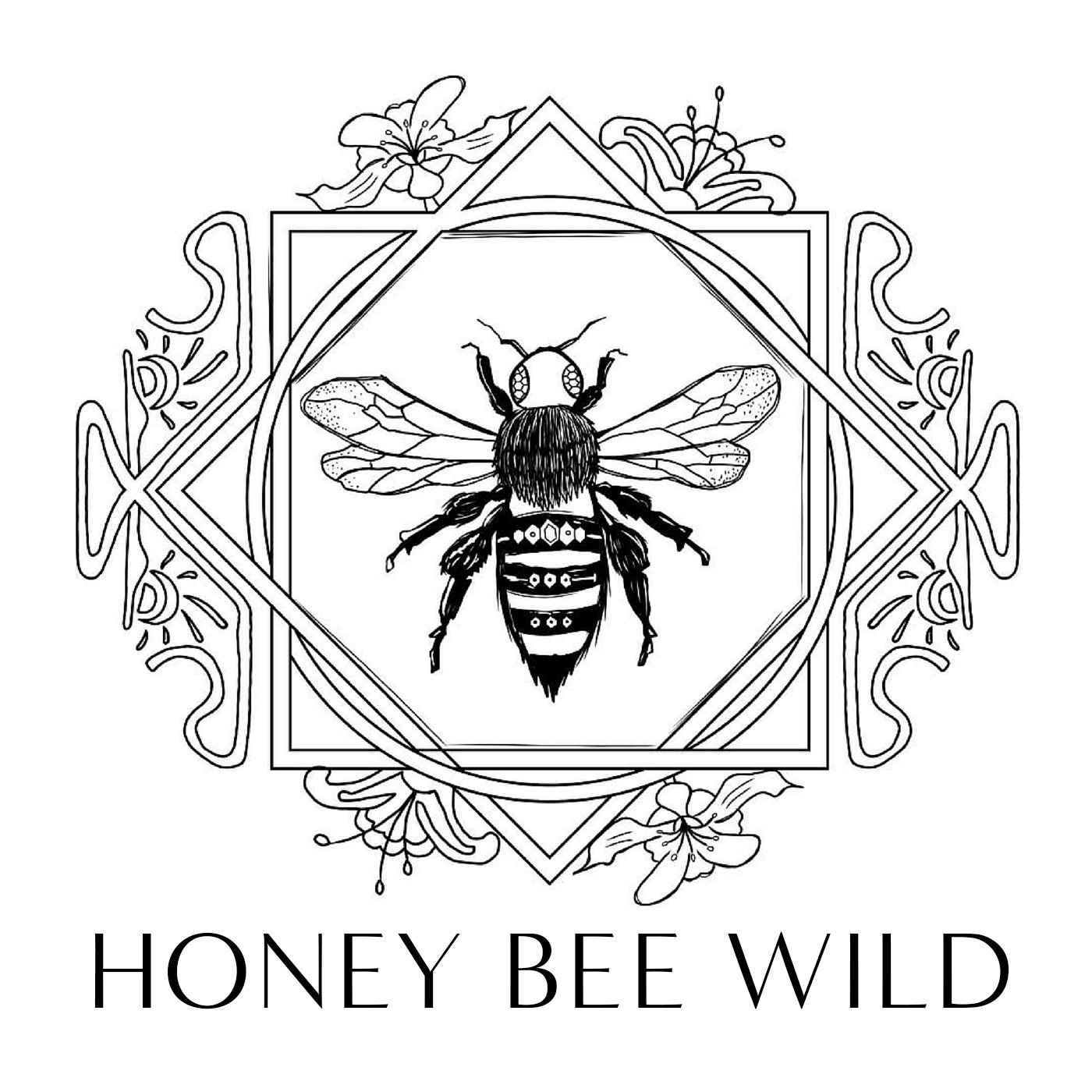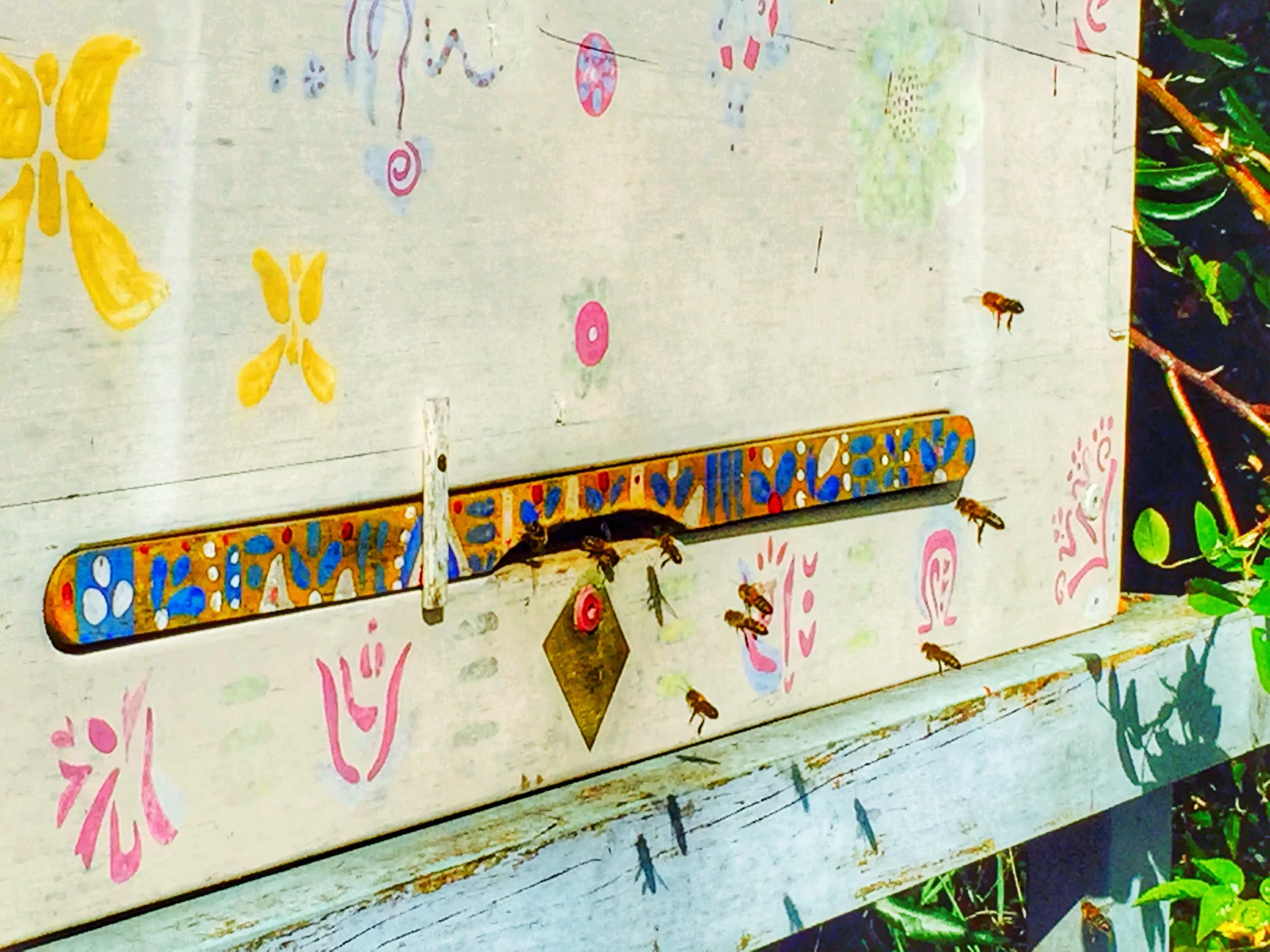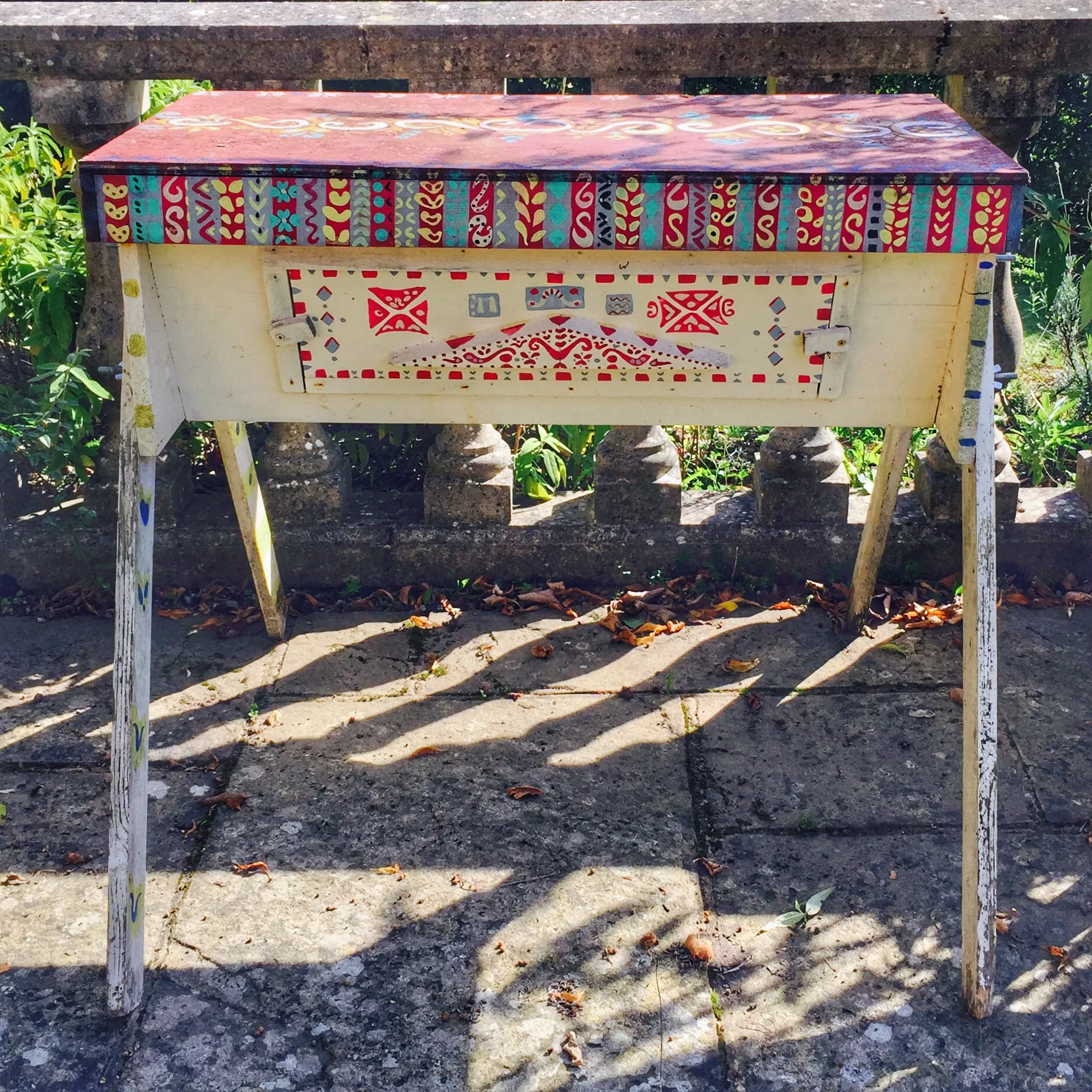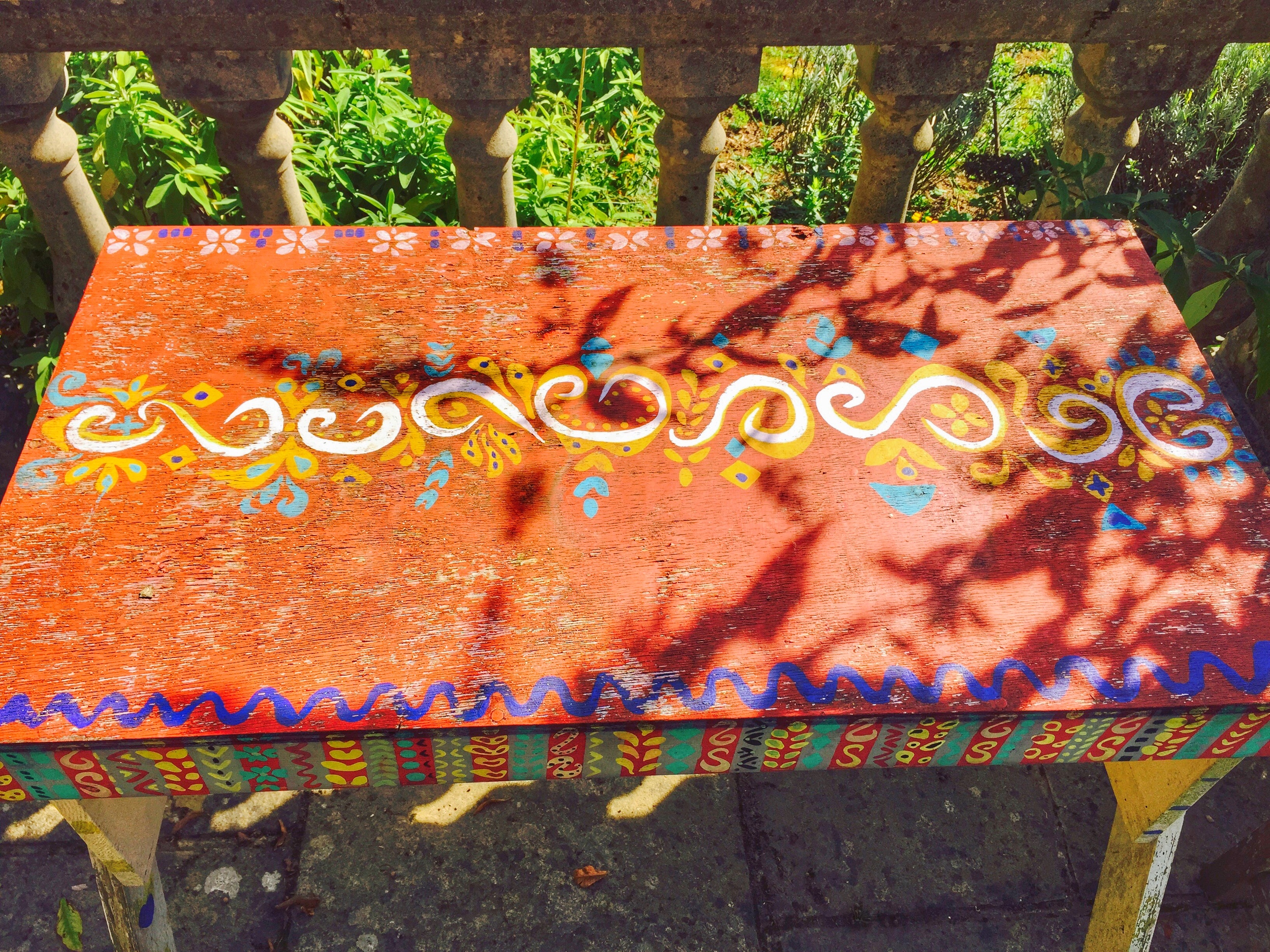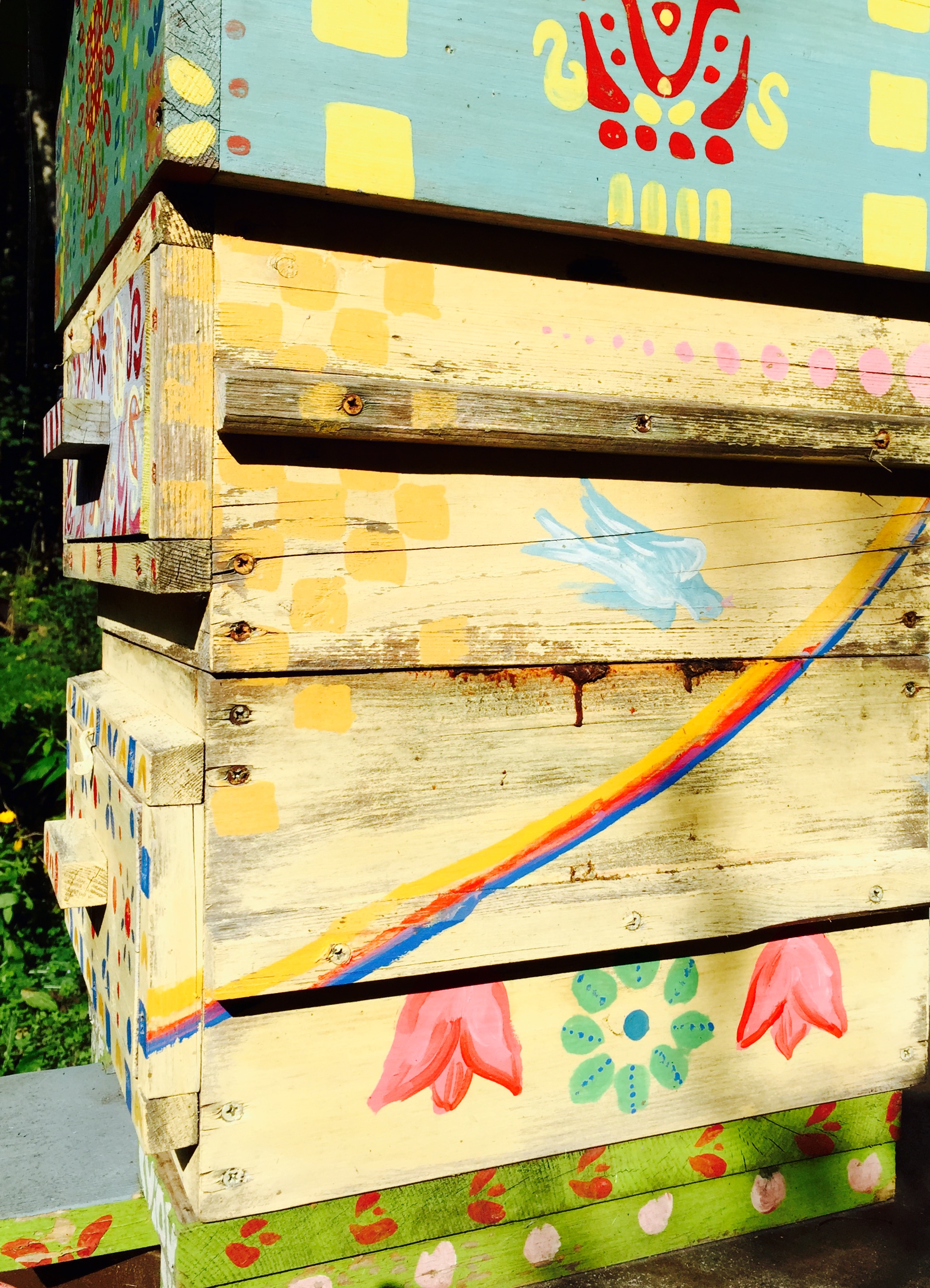The Natural Beekeeping Trust
My dream of the apiary exist at the Natural Beekeeping Trust. A place of serenity and joy, filled with the life-affirming site of flowers, colorful hives and humming bees. On an brilliant autumn day in September, the sky is clear and the sunshine awakens hives to a prosperous day of foraging.
Heidi Herrmann, trustee of The Natural Beekeeping Trust, is kind enough to grant a friend and I hours of her time, introducing us to hives at various garden locations associated with the Trust, and speaking extensively about natural beekeeping.
The Work of the Trust:
Heidi works for The Natural Beekeeping Trust providing courses, talks and seminars regarding bees and natural beekeeping in England and abroad. She has most recently participated in Beeholdium, a conference based in Glastonbury, England, dedicated to the sacred bee and holistic bee-centric guardianship.
In world of modern beekeeping borne of the industrial age and Big-Ag, The Natural Beekeeping Trust is peopled by pioneers of bee-centric beekeeping. They are one of the few organizations at the forefront of natural beekeeping in the UK and internationally.
Their homepage reads: “We encourage ‘bee guardianship’ - keeping bees for the bees' sake - and advocate organic/biodynamic gardening and farming. Our apicentric approach is guided by the wisdom of the bees insofar as we are able to encompass it, and supported by sound science.”
Visiting the Hives:
The hives of The Natural Beekeeping Trust are some of the most vibrant, beautiful hives I have every witnessed. They are a different sort of hive with a different kind of hive guardian, for they are alive with the artistic beauty of both human and honey bee. They are gorgeously painted, alternative hive styles, treatment-free and thriving with minimal intervention. On a day like today, some hives are busy pollinating early autumn flowers, while others cluster quietly around the entrance. Heidi points out a hive that is doing orientation flights. This is something young bees do when familiarizing themselves with their surroundings. I ask Heidi how she can tell, and while she indicates the physical signs such as looping flight movements happening in front of the hive, she speaks more to the energy you can feel coming from the hive.
Heidi is a bee-guardian of deep listening. The more I travel, the more I find beekeepers who believe beekeeping is a relationship to a species that requires the utmost respect and inner listening. The kind of listening that requires going quiet within, allowing us to sense the message coming from a bee-ing of vibration and light, darkness and hum. This is not to exclude keen observation and scientific understanding, but rather to add a deeper layer of knowledge that can not be reached through intellectual observation alone. Indeed, Heidi makes it her business to read every book she comes across regarding bee, and stays informed on all the current scientific research.
Bees’ intelligence:
Over a warm drink of french press coffee served in delicate blue and white ceramic tea cups, Heidi discusses the nature of bees and her work with the Trust. For Heidi, the bee is a highly supreme being. A creature of infinite intelligence, more evolved than the human being, and from whom we have much to learn. This is one reason why The Natural Beekeeping Trust promotes treatment-free beekeeping and stands firmly against neonicotinoid pesticides, known to be a major contributor to the global increase of bee colony deaths. When given the time and space, bees, in their exquisite brilliance, know the best ways to manage their space and their colony.
Heidi shows us an example of a hive made up of a couple of beautifully painted warré boxes, and topped with a skep. Bee skeps are tightly woven straw baskets, overturned with an entrance at the bottom or the side. They have been used throughout Europe for centuries. This skep, it turns out, was not strong enough to support the weight of the growing colony. As a result, the bees propolised the entire interior of the skep, transforming a sagging basket into a rock-hard, fortified palace.
Bees use propolis, collect with great effort from tree and shrub sap, to line and protect their hive and hive entrances. I have seen it used to warden off a black widow living within a hive or to close up a less desirable entrance in favor of another. The same hive described above actually used propolis to glue crystals and stones Heidi had placed around the skep, creating a number of secure and defendable entrances into the hive.
Heidi has seen all manner of hive management by the colonies in her 16 years as a beekeeper. She has observed hives do things that make little sense to the conventional beekeeper or the season at hand. Things we, as beekeepers are taught to stop, change, rearrange. In Heidi, I see a guardian who understander how to trust the larger weaving of life. The tapestry that goes goes beyond one season, one year, one honey crop. This isn’t to say natural beekeeping is completely hands off, but rather, asking the human guardian to listen to language of the bee first, and the agenda of the human second.
For example, in one hive, we find slugs. Heidi muses that the slugs are always in the hives and that they may annoy the bees, but they could equally be adding something to the overall ecosystem of the hive. This reminds me of some of the eco-floor hive styles that I’ve read about with people like The Barefoot Beekeeper. Remember that bees in the wild predominately habitat hollow trees. Trees filled with bacteria, bugs and microorganism that provide a much more balanced eco-system than you will find in most conventional hives.
“Putting chemicals in the hive doesn’t just contaminate your hive products, the honeybee is susceptible to some of the miticides....It’s just trade off against the damage to the bee and the damage to the mite….But worse still, because some of these actors are kinds of antiseptic, they seriously disrupt the microbiological environment in the hive. Bees hugely depend on the other organisms, the microorganisms in the hive, for a healthy ecology of their hive, for the health of their young and the health of themselves.”
Chemical-Free Beekeeping:
Perhaps one of the most controversial aspects of natural beekeeping is the practice of not using chemicals in the hive to treat mites. Heidi was not always a natural beekeeper. She began learning, as many of us do, with a more conventional beekeeper. She said things changed for her, the day she stayed too close to a hive after a treatment. When treating a hive with certain gases/chemicals (organic or no), there are precautions the beekeeper must take, so as not to be adversely effected. These include remaining a safe distance from a hive post-treatment. One the day Heidi stayed too close post-treatment, she described hearing the most despairing moan emanate form the hive, and knew in that moment, she had to find another way to work with the bees.
“The Natural Beekeeping Trust was established in order to be of assistance to anyone seeking advice and tuition in bee-friendly practice - holistic, chemical-free beekeeping - and to demonstrate sustainable bee husbandry in the context of organic/biodynamic horticulture”
Heidi has dedicated her life to the bee and educating people on natural ways to work with bees. She describes the shock she’s experienced time an again from beekeepers who simply can not believe her hives have thrived and survived without treatment. Don’t misunderstand, if you are going to become a natural beekeeper, you will loose hives to varroa or disease. However, data suggests that conventional, treated hives suffer equal if not greater losses. Regardless of this growing evidence, there is still a widespread believe that if you do not treat your hives, all your bees will die.
I have been a treatment-free beekeeper for the past 6 years and have suffered losses as well as maintained strong, lasting colonies. Usually my losses have less to do with treatment issues, and more to do with mistakes I’ve made in my learning curve such as not recognizing the signs that a colony needs to be fed (often due to California drought), or not realizing in time that a swarm was queenless. I have also had less success maintaining strong colonies with conventional langstroth hives, while my top bar hives remain strong despite varroa issues. I believe much of this has to do with providing the colony with an uninterrupted brood chamber. The brood is the nest, or the womb of the colony, where baby bees are born. To enter a langstroth hive, you must often separate this chamber, disrupting the reproductive center of a colony. There are hive designs such as top bar, skep, one-room and log hives, that are much less invasive. Read more about Natural Beekeeping vs Conventional Beekeeping here.
Giving, Not Taking:
Aside from treatment-free beekeeping, Heidi and those at the Natural Beekeeping Trust do not take from the hives. She believes instead, that it is the bee-guardian’s role to give to the hives. The hives of the Trust are not used for honey production. This attitude on beekeeping for the bees and not for the honey can be challenging, even for other natural beekeepers. Heidi’s response is to ask people, do they know what the weather is going to be like two to three years from now? Because that’s the amount of foresight you need to ensure you are not taking honey that the bees depend on for survival. Do you know what the forage sources are in your garden? In your neighborhood? Do you know how the nectar and pollen sources have been this season, last season? If you really want to help the bees, let us begin with planting food sources for them. And remember to also plant flowers that provide nectar and pollen during the less abundant times of year.
Engaging with the Art of Hive Painting:
We finish our visit with a walk through one of the garden locations, rimmed with hives. We see one-room hives, as well as warré style hives and a top bar. I have dreamed of visiting the Natural Beekeeping Trust since I became a beekeeper. Aside from their beekeeping practices, I am particularly drawn to the beauty and artistry seen in the hand-painted hives. Every single hive on the property, inhabited or no, is painted in bright colors and exquisite patters.
Heidi tries to prepare empty hives by painting beautiful symbols and designs on the boxes. For her, it is a matter of connecting with the future colony that will be living inside the hive. Creating the dream that is the future realized vibrate colony. Sometimes she also paints hives with bees already living inside. In these moments, she is always moved by the awareness of the hive. They seem to know her love and intention in her artistic offering. Beauty is powerful. It transcends. It evokes. It calls forth spirit. When walking past hives managed by the Trust, I feel the magnificent importance of Sanctuary. I am convinced that some of the most incredible work we can do as earth guardians is to create sanctuaries for the honey bee. And beyond this, to create garden sanctuaries where humans can experience the wisdom of the bee and be suffused with the primordial intelligence of the hive hum.
A Way to Contribute:
The Natural Beekeeping Trust is an organization making real change in how we perceive bees and horticulture. They are helping to radically shift our ideas around beekeeping and promote a kind of bee-guardianship that is heart-centered, informed by science and infused with spirit. There are a number of projects the Trust needs community support in manifesting. More than anything, they need financial support to attend the many talks and conferences they are invited too, and to make manifest more bee sanctuaries. They are one of the absolutely best bee organizations out there! Regardless of whether you are living in the UK or not, The Natural Beekeeping Trust is a group worth supporting. You can become a friend of the trust or donate here.
I hope you find these photos and the work of the Trust as inspiring as I have.
